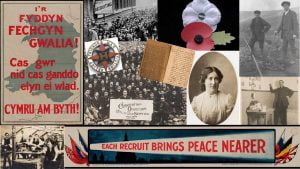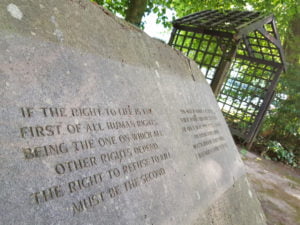Conscientious Objectors in Wales
The right to voice opposition to our government’s involvement in international conflicts – such as the recent wars in Iraq, Afghanistan and Syria (through movements such as ‘Stop the War’) – is a right which we take for granted today as part of the fabric of UK democracy. But 100 years ago, in World War One, to stand up for your beliefs through refusing to kill – ‘conscientious objection’ – commanded a prison sentence.
- Wales’ Heritage of Opposing Conflict: WW1 to today, COs Day 15 May 2019
- ‘Belief and Action’ – WCIA’s hidden histories and touring exhibition exploring opposition to war.
- WCIA Learning Resources on Objecting to Conflict, on Hwb
- WCIA Review of ‘Opposition to the Great War in Wales’, COs Day 15 May 2019
Over 900 men from Wales objected to fighting in WW1 as a matter of conscience. In 1916, with the introduction of military conscription, many conscientious objectors were imprisoned for their beliefs, their stories largely hidden from history. To mark the centenary of the Military Service Act in March 2016, their bravery was recognised with the launch at the Abergavenny National Eisteddfod by WCIA of a searchable ‘Peace Map of Conscientious Objectors’.
 The Pearce Register of WW1 Conscientious Objectors
The Pearce Register of WW1 Conscientious Objectors
WCIA are indebted to Cyril Pearce, Honorary Research Fellow on ‘Legacies of War’ at the University of Leeds, for sharing his meticulous life’s work in collating the ‘Pearce Register’. He has been working on the history of British 1914-18 war resisters for some years, having published ‘Comrades in Conscience’ in 2001, and ‘Communities of Resistance’ in 2016.
What sort of information can be found through the Pearce Register? Here’s a typical entry, recording the fate of Reverend Benjamin Meyrick, an ordained minister who was jailed:
“4.7.17 to Wrexham barracks, refused medical and refused uniform. 6.7.17 Taken to Litherland Camp, Liverpool – released on bail; surrendered himself to Bangor Police Court 25.9.17; 3 R.Welsh Fusiliers Court Martial Litherland 8.10.17 – 2 years With hard labour, Wormwood Scrubs.”
Court Martial Outcome, Pearce Register entry for Rev. Benjamin Meyrick
How do I search for Objectors?
- Go to the Wales Peace Map; tick the ‘Pearce Register’ box.
- 2. A search bar will appear across the bottom of the map, and the full list of Pearce Register entries will appear in a table below the search bar (5 entries per page). You can filter/search in the following ways:
- filter by name: type a name, or part of a name, into the box. All entries containing this name will appear.
- filter by county: select any of the counties from the drop down list. These are the Welsh counties prior to 1994
- filter by town: type in any town or village to find the entries from that location (not every entry has this information
- filter by motivation: select any motivation from the list and the results will appear below)
3. Click ‘Find out more’ on any entry to see full details from the Pearce Register, from information about tribunals to prison service details. A few pointers of note:
- Numbers in brackets after a name refer to the individual’s army number.
- Some entries have specific addresses, and these appear as ‘pins’ on the Peace Map. Those without address information do not appear as pins.
- Gaps in the record are because some information is unknown. We welcome volunteers to uncover these gaps, and the ‘stories behind the names’ in the register.
Belief and Action
WCIA’s produced a touring exhibition and collections of ‘hidden histories’ exploring opposition to war: click below to find out more.


